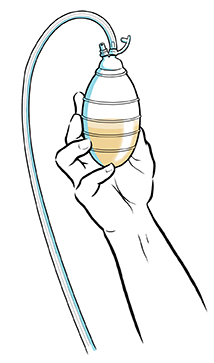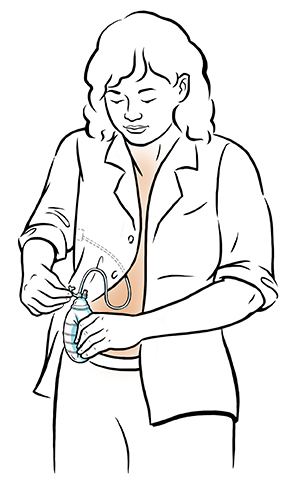Mastectomy: After Surgery
Mastectomy: After Surgery

Right after surgery
You will wake up in the recovery room, where you will be closely watched. You may have an IV (intravenous) line for medicines and fluids. Once you are fully awake, you will be taken to your room, where you can have visitors. Expect to be up and walking soon after surgery. You will be given pain medicine if you need it. It's important to get out of bed and move around, even though it may be hard to do. Activity can help get your digestive tract moving, help prevent blood clots, and help get air moving normally through your lungs. Use the pain medicine to be comfortable so you can get up.
Your first look

At home
You are likely to go home a few days after surgery. Before leaving, you will receive instructions on home care. You may have:
One or 2 soft plastic drains. These draw off fluid from around the incision. Be sure to empty your drain at least every 8 hours, or as directed. Remove the plug and empty the contents into the container provided. Measure the amount of fluid as directed. Write it down to show your healthcare provider. The drainage will decrease as you heal. The drains will be removed at the healthcare provider's office, usually within 2 weeks of surgery.
A bandage (dressing) over your incision. Care for the dressing or bandage as directed. Take sponge baths at first to avoid getting it wet. Your healthcare provider will tell you when it's OK to take off the bandage and when it's OK to stop using one.
Stitches at the incision site. They may dissolve on their own. Or they may be removed at your follow-up visit. Ask your healthcare provider what to expect.
Pain medicines to help relieve any discomfort. Medicines should be taken as directed.
An activity or exercise plan. Make sure you know what you can and can't do. You will be given exercises to help keep normal movement in your shoulder, build your arm and chest muscle strength, and help decrease swelling.
A follow-up appointment. Find out when you will need to see your healthcare provider next and what to expect as the next part of your treatment.
Talk with your healthcare provider about what problems to look for and when to call them. Know what number to call with questions or problems, including after office hours, on weekends, and on holidays.
Updated:
February 09, 2018
Reviewed By:
Gersten, Todd, MD,Stump-Sutliff, Kim, RN, MSN, AOCNS